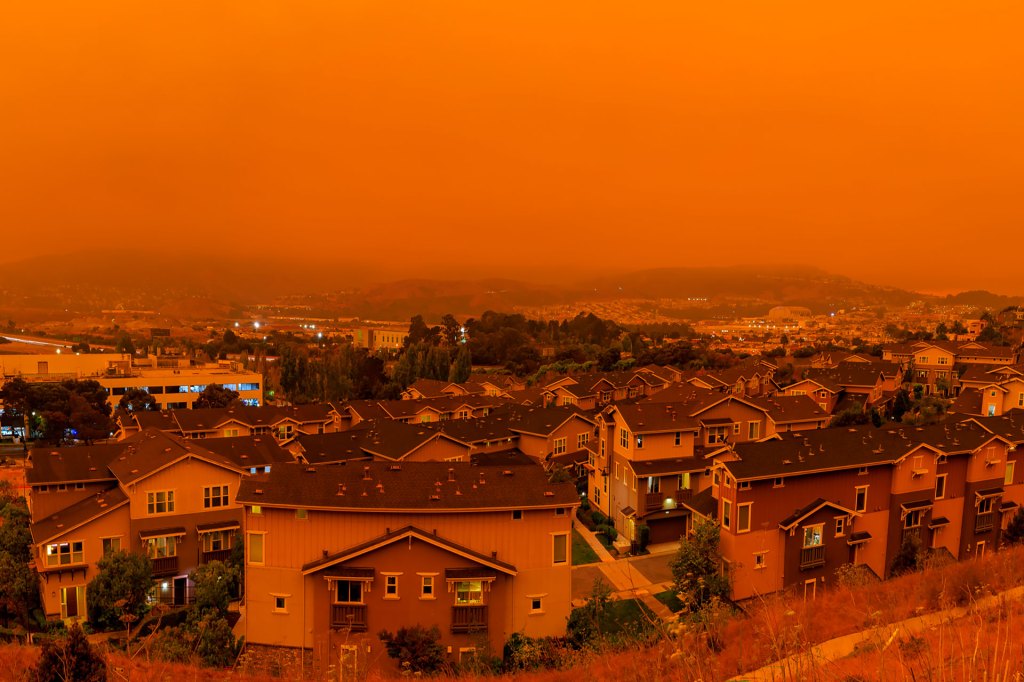In fall of 2018, a week after the deadliest fire in California’s history, smoke continued to billow south over the capital and into the San Francisco Bay. Hardware stores had long since sold out of N95 masks (before most people knew what they were) and you could not find air purifiers at online retailers. Bay Area residents who could work remotely (before it was the norm), could still turn to the web and find vacation rentals a few hours away to access clean air. Watching the response to this ‘smoke wave,’ it was more apparent than ever that the ability to cope with and avoid disasters like this one depends on access to opportunity and capital.
Dramatic increases in wildfire smoke exposure
In a 2021 research brief, “Disruptions from Wildfire Smoke: Vulnerabilities in Local Economies and Disadvantaged Communities in the U.S.,” the San Francisco Fed highlighted the growing threat of heavy wildfire smoke and its disparate impacts on low- and moderate-income communities. The report discussed how smoke exposures for certain populations such as frontline workers, housing-vulnerable populations, and young students living in poverty, have increased dramatically. Smoke from wildfires — an unplanned, unwanted fire burning in a natural area, such as a forest, grassland, or prairie — can interrupt business and has important economic implications, including increased occupational hazards for outdoor workers. It can affect school closures and increased costs for renters and homeowners.
Some areas saw a staggering increase of hundreds of percent in smoke exposure over the past decade. For example, the largest percentage increases in heavy smoke days for frontline workers – workers in agriculture, construction, and shipping that often occur outdoors – occurred in California (2132%) and Arizona (1124%). While the increase was noted nationwide, some of the most striking examples were found in the western part of the United States.
The San Francisco Fed released a set of regional data tools to investigate wildfire smoke and disadvantaged communities more closely.
Data sheds a light smoke exposure in disadvantaged communities
In August of 2023, the San Francisco Fed hosted a webinar to better understand how communities and businesses have been navigating the economic impacts of increasing wildfire smoke and their actions to build resilience. The event invited industry, small business, and community leaders who shared concrete examples of how wildfire smoke has impacted local economies, as well as promising practices to increase economic and community resilience.
The work calls attention to the potential for large wildfires to disrupt communities located far from the fires. Research has shown that income is closely tied to seeking out protective actions, like personal air purifiers. And so the brief also highlights some of the strategies to build economic resilience to such far-off risks, learning from communities at the frontlines. Today the SF Fed is continuing that effort, by expanding the data for the entire US and updating it to include the years 2022 and 2023, the latter of which brought heavy wildfire smoke to many parts of the country in ways they had not experienced before.
Key findings: increasing smoke days and economic disruptions
Recent data show a concerning rise in person-days (person-days are used to capture, together, the number of people and the amount of time spent under smoke plumes) under heavy smoke plumes nationwide. The extended “smoke season” poses challenges for businesses and labor alike, emphasizing the need for proactive resilience measures.
On the ‘Time Series’ tab in the dashboard below you can see the cumulative number of person-days for the US in each year 2011-2023. For light and medium density smoke plumes, 2023 had the highest total of person-days for any year in the data (for the heaviest smoke category, 2023 was second highest). For each category of smoke, you can see smoke season expanding, as the curves begin to climb earlier in the year. This extends the timeframe when smoke-related disruptions are experienced by businesses or labor and may increase the need for protective or recovery actions and investments.
The smoke in 2023 was notably related to large wildfires in Canada, where smoke had moved south and impacted many parts of the upper Midwest and the Northeast (see Table1). The dramatic presence of heavy wildfire smoke in large US cities (for example, New York City) in June 2023, brought increased attention to this issue in many parts of the country which had not been prepared to deal with smoke. It also illuminated more economic disruptions including the postponement of sporting events and Broadway shows and cancellation of flights into the region.
The SF Fed’s Wildfire Smoke Data Tool now covers all of the US states and includes updated data through the end of 2023. The tool allows users to view data summarized by Federal Reserve district (Table 1) or by county.
Table 1. Heavy Smoke Exposures by Federal Reserve Bank District
| Fed District |
Annual Heavy Smoke Person-days (2011-22, millions) |
Heavy Smoke Person-days (2023, millions) |
Annual Heavy Smoke Days (2011-2022 avg) |
Heavy Smoke Days (2023) |
|---|---|---|---|---|
| 1 – Boston | 20.4 | 118.4 | 1 | 8 |
| 2 – New York | 34.8 | 336.8 | 2 | 13 |
| 3 – Philadelphia | 14.2 | 153.4 | 1 | 12 |
| 4 – Cleveland | 36.6 | 258.7 | 2 | 14 |
| 5 – Richmond | 25.0 | 231.5 | 1 | 8 |
| 6 – Atlanta | 17.1 | 116.8 | 1 | 3 |
| 7 – Chicago | 136.0 | 549.7 | 4 | 15 |
| 8 – St. Louis | 30.9 | 109.7 | 2 | 7 |
| 9 – Minneapolis | 62.0 | 157.8 | 8 | 19 |
| 10 – Kansas City | 68.7 | 61.4 | 4 | 4 |
| 11 – Dallas | 28.6 | 21.3 | 1 | 1 |
| 12 – San Francisco | 249.9 | 105.0 | 6 | 3 |
The impacts of extreme weather and natural disasters that are increasingly frequent and intense are no longer far off temporally or proximally. The SF Fed’s research on wildfire smoke and other weather-related hazards highlights that fact that escaping such hazards is an option that not all households or workers or children have. Faced with these challenges, places are beginning to examine solutions, learn from frontline communities, and implement strategies that strengthen local economies. Data like those discussed here help tell more complete stories of where climate hazards intersect with economic exclusion. And resulting actions taken to protect against one hazard can often improve readiness for others. Economic resilience depends on community development that recognizes risks and emphasizes opportunities for affected communities to advocate for more impactful solutions.







